Select units of measurement for the temperature and rainfall tables (metric or imperial).
Average weather, temperature, rainfall, sunshine
In much of South Korea (Republic of Korea), the climate is
continental, cold but often sunny in winter, and hot and sultry, with abundant rainfall, in summer. Along the southern and eastern coast, where the winter is milder, and the average January temperature exceeds the freezing mark, the climate can be defined as
temperate. Spring and autumn are quite short but pleasant.
The latitude of the country is not high: the border with North Korea is located on the 38th parallel, but winter is cold because of the prevailing winds from Siberia.
In the following map, we can see the
climate zones in South Korea.
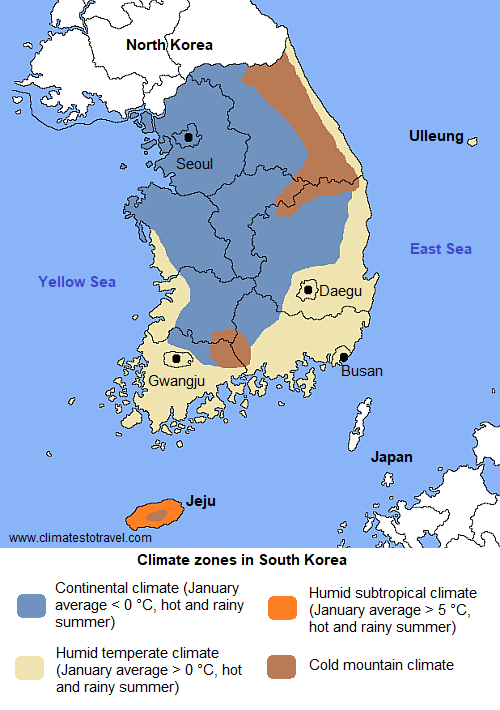
South Korea is affected by the Asian
monsoon regime: in winter, cold air masses from the Asian continent prevail, while in summer, the country is reached by warm and moist air masses of tropical origin. For this reason, the
precipitation pattern is opposite to that of the Mediterranean climate: the driest season is winter, while the rainiest one is summer. Moreover, in summer and early autumn, South Korea can be affected by
typhoons (see below).
Total annual
precipitation is significant, spanning generally from 1,200 to 1,500 millimeters (47 to 60 inches), with the exception of both the southern coast, where it is higher and can reach 1,700 mm (67 in), and the northernmost inland regions, where it is lower and can go down to 1,000 mm (40 in), in addition to some particularly sheltered valleys like that of
Daegu (or Taegu), where it does not exceed 1,000 mm (40 in) per year.
The climate in detail
The seasons
Winter, from late November to mid-March, is freezing in the north and in the interior, while it’s milder, but still with night frosts, along the southern coast. The sun often shines. Snowfalls are relatively rare and not abundant. A cold, dry wind often blows from the continent, at times full of dust.
Because of the greater exposure to cold winds of Siberian origin, at a given latitude, winter is colder on the west coast than on the east coast. The average January temperature exceeds 0 degrees Celsius (32 °F) in the south, on the coast and in the plains, while on the east coast, it's around freezing even in the north. The interior is obviously colder than the coastal areas, in fact, in the north-central inland area (see Chuncheon) the average temperature in January is around -3.5 °C (25 °F).
In the capital, Seoul, located near the coast but in the north-west, which, as we mentioned, is the region most exposed to cold winds, the average temperature in January is -2 °C (28 °F).
In the southernmost cities, such as Mokpo and Busan (or Pusan), the climate is much milder, and the average temperature in January goes up to around 3 °C (37.5 °F).
However, during
cold spells, the temperature can drop to -20 °C (-4 °F) in Seoul and in northern inland areas and to around -10 °C (14 °F) in the south, while it only drops a few degrees below freezing on the island of Jeju.
The north-east is mountainous, and in addition to being freezing, it is also quite
snowy. This is the region (called
Gangwon-do) where there is the largest number of ski lifts, which, given the low temperatures, are also found at quite low altitudes, below 1,000 meters (3,300 feet). The highest mountain in the area is Seorak, 1,708 meters (5,604 feet), protected in a national park.
In winter, not only the mountains, but also the northeast coast is a bit wetter (although it is milder): in this season, the average monthly precipitation along the north-east coast is about 45/60 mm (1.8/2.4 in), while in Seoul, it is about 20/25 mm (0.8/1 in). The southwest coast (where Mokpo is located) and Jeju Island are a bit more rainy and less sunny as well.
The least snowy area is the south-east coast because of the higher temperature, but also because in periods of bad weather the wind blows from the south. There are, on average, 25 days with snowfall per year (maybe light) in Seoul (as mentioned, located in the northwest), 22 days in Incheon (near Seoul but on the coast), 27 in Mokpo (on the south-west coast, which is a milder but also more humid area), 12 in Daegu (in the south-eastern inland areas), and only 5 in Busan, on the southeast coast.
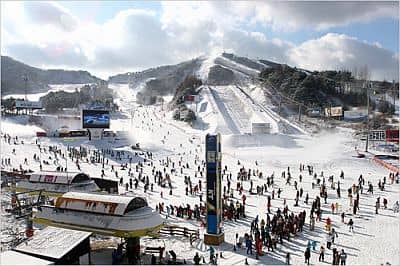 Spring
Spring, from mid-March to May, is initially cool, and gradually becomes milder, but the rains become more frequent because of the formation of low pressure systems.
In winter, and especially in spring (March to May, which is called
yellow dust season), South Korea (but especially the Seoul area) can be reached by the
yellow dust (
HwangSa in Korean) coming from the desert of Mongolia and from China; the dust forms a characteristic haze and can cause breathing problems and eye irritation.
Summer, from June to August, is hot, humid, and rainy. High humidity makes the heat sweltering, especially in July and August. Rainfall can be heavy especially in July and August. Two thirds of the annual rainfall occur in summer. However, between periods of bad weather, there can also be sunny days, which may be very hot. On the hottest days the temperature can reach 36/38 °C (97/100 °F).
Especially between late June and early August, an almost stationary front (called
Changma) moves over Korea, which can cause heavy rainfall (sometimes associated with floods) but also fog, low clouds and drizzle. In the second part of summer, it goes a bit better, and the amount of sunshine increases, although typhoons can add more rain.
Being characterized by different periods of bad weather, summer is the least sunny season, at least if you consider the length of the day.
Autumn, from September to late November, is a pleasant season, especially in the month of October, when the maximum temperatures are around 20/22 °C (68/72 °F). In addition, it usually rains less than in spring.
Center-north
In the center-north, winter is very cold, in fact, the average January temperature is equal to or lower than 0 °C (32 °F). As mentioned, the coldest areas are those of the interior. On the other hand, summer is hot and muggy.
Pyeongchang
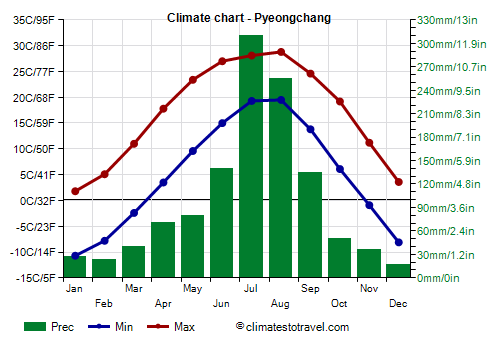
For example, in
Pyeongchang, at 300 meters (985 feet) above sea level, where the 2018 Winter Olympics were held, the average temperature ranges from -4.5 °C (24 °F) in January to 24 °C (75 °F) in August.
On average, 1,255 mm (49 in) of rain (or snow) fall per year.
Seoul
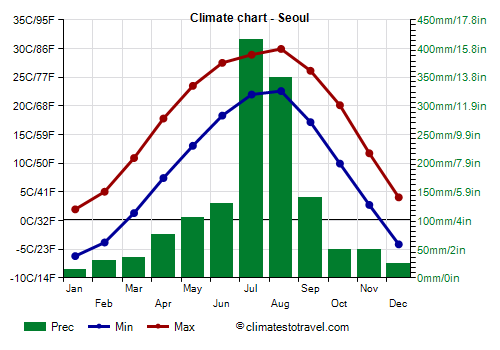
As mentioned, winter in
Seoul is very cold, although it is quite sunny. On the other hand, summer is hot and muggy, with an average of 26.3 °C (79 °F) in August.
Precipitation amounts to 1,400 mm (55 in) per year. The summer is clearly the rainiest season, and also the least sunny season because of the monsoon.
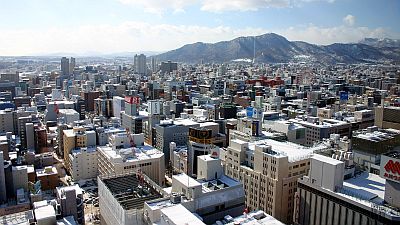
Near Seoul, in
Incheon, the Yellow Sea is very cold in winter, but it warms up a lot in summer, reaching 25.5 °C (78 °F) in August, when the water temperature is sufficient for swimming.
Off the east coast, in the East Sea (or Sea of Japan), we find the island of
Ulleung.
The south
In the south (see Gwangju, Daegu, Busan), winter is not as cold as in the center-north, and as mentioned, the average temperature slightly exceeds freezing even in January. Summer is hot and muggy here as well.
Busan
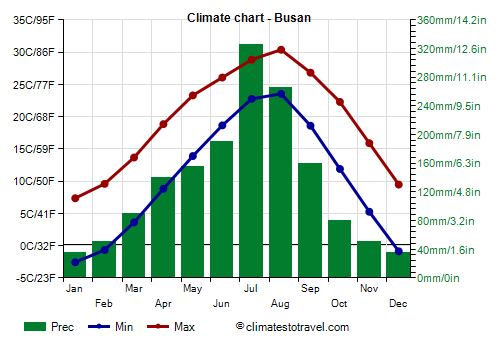
In
Busan, located on the southeastern coast, which in winter is the warmest area of the country, the average temperature ranges from 2.5 °C (36.5 °F) in January to 27 °C (80.5 °F) in August.
Precipitation in Busan amounts to 1,575 mm (62 in) per year. Here too, the summer is the rainiest season.
Near Busan, and along the southern coast, the sea is much less cold in winter, while in summer, it gets a bit warmer than in Seoul, reaching 26 °C (79 °F) in August.
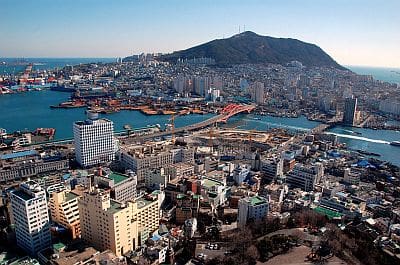
The southern island of
Jeju (or Cheju) is even milder, so much so that the climate can be defined as subtropical: here, the average temperature in January is about 6/7 °C (43/45 °F). On the other hand, the winds coming from the continent pick up moisture from the sea before reaching the island, so the winter here is often windy and rainy.
Typhoons
As mentioned, South Korea can be hit by
typhoons. Typhoon is the name given to tropical cyclones in East Asia. Typhoons are accompanied with large amounts of rainfall and strong winds, and usually produce the greatest damage on the south coast and Jeju Island.
Typically, typhoons affect Korea from July to early October, with a higher probability in the first half of September. Sometimes, they also arrive in the second half of June, when they are generally less strong and only affect the extreme south.
When to go
Considering both the cold winter and the hot and rainy summer, the best times to visit South Korea are
spring and autumn, especially the months of May and October. The latter can be preferred because it's less rainy (and it's outside the so-called
yellow dust season). Moreover, in autumn, you can admire the fall foliage in national parks.
As mentioned above, the sea is warm enough for swimming from July to September, especially in the center-south.
What to pack
In
winter: for Seoul and the center-north, bring warm clothes, such as a down jacket, gloves, a scarf, and a hat. For the extreme south, Mokpo and Busan, warm clothes, such as a sweater and a jacket; a scarf, gloves and a hat for the evening, and possibly a raincoat or umbrella.
In
summer: bring light clothes of natural fibers, a light raincoat or umbrella, a scarf for the wind, and a light sweatshirt for air-conditioned places.
It is customary to remove shoes before entering homes and temples, so it can be useful to bring shoes without laces, or that are at least easy to take off.
Climate data - South Korea
| Busan |
|---|
|
| Jan | Feb | Mar | Apr | May | Jun | Jul | Aug | Sep | Oct | Nov | Dec |
|---|
| Min temp. | -3 | -1 | 4 | 9 | 14 | 19 | 23 | 24 | 19 | 12 | 5 | -1 |
|---|
| Max temp. | 7 | 10 | 14 | 19 | 23 | 26 | 29 | 30 | 27 | 22 | 16 | 9 |
|---|
| Precip. | 35 | 50 | 90 | 140 | 155 | 190 | 325 | 265 | 160 | 80 | 50 | 35 |
|---|
| Prec. days | 5 | 6 | 8 | 9 | 9 | 10 | 14 | 12 | 9 | 5 | 6 | 5 |
|---|
| Humidity | 53% | 54% | 59% | 61% | 66% | 72% | 79% | 75% | 72% | 65% | 61% | 55% |
|---|
| Day length | 10 | 11 | 12 | 13 | 14 | 14 | 14 | 13 | 12 | 11 | 10 | 10 |
|---|
| Sun hours | 7 | 7 | 7 | 7 | 7 | 6 | 6 | 6 | 6 | 7 | 7 | 7 |
|---|
| Sea temp | 14 | 13 | 13 | 14 | 17 | 20 | 23 | 26 | 24 | 22 | 19 | 17 |
|---|
| Cheongju |
|---|
|
| Jan | Feb | Mar | Apr | May | Jun | Jul | Aug | Sep | Oct | Nov | Dec |
|---|
| Min temp. | -6 | -4 | 1 | 7 | 13 | 18 | 22 | 23 | 17 | 9 | 3 | -4 |
|---|
| Max temp. | 3 | 6 | 12 | 20 | 25 | 28 | 30 | 31 | 26 | 21 | 13 | 5 |
|---|
| Precip. | 20 | 30 | 45 | 75 | 85 | 140 | 295 | 275 | 140 | 60 | 45 | 25 |
|---|
| Prec. days | 7 | 6 | 8 | 8 | 8 | 9 | 16 | 14 | 9 | 6 | 9 | 9 |
|---|
|
|
| Sun hours | 5 | 6 | 7 | 7 | 8 | 7 | 5 | 6 | 6 | 7 | 5 | 5 |
|---|
|
| Cheorwon |
|---|
|
| Jan | Feb | Mar | Apr | May | Jun | Jul | Aug | Sep | Oct | Nov | Dec |
|---|
| Min temp. | -12 | -9 | -3 | 3 | 10 | 16 | 20 | 20 | 14 | 6 | -1 | -9 |
|---|
| Max temp. | 1 | 4 | 10 | 18 | 23 | 27 | 28 | 29 | 25 | 19 | 10 | 3 |
|---|
| Precip. | 20 | 25 | 30 | 70 | 100 | 120 | 400 | 345 | 120 | 50 | 50 | 20 |
|---|
| Prec. days | 6 | 6 | 7 | 8 | 9 | 11 | 17 | 14 | 8 | 7 | 8 | 8 |
|---|
|
|
| Sun hours | 6 | 6 | 6 | 7 | 7 | 7 | 5 | 5 | 6 | 6 | 5 | 5 |
|---|
|
| Chuncheon |
|---|
|
| Jan | Feb | Mar | Apr | May | Jun | Jul | Aug | Sep | Oct | Nov | Dec |
|---|
| Min temp. | -9 | -7 | -1 | 5 | 11 | 17 | 21 | 21 | 15 | 8 | 0 | -7 |
|---|
| Max temp. | 2 | 5 | 12 | 19 | 24 | 28 | 29 | 30 | 26 | 20 | 11 | 4 |
|---|
| Precip. | 20 | 30 | 35 | 70 | 100 | 125 | 400 | 320 | 130 | 50 | 50 | 25 |
|---|
| Prec. days | 6 | 6 | 7 | 8 | 9 | 10 | 16 | 14 | 8 | 6 | 8 | 8 |
|---|
|
|
| Sun hours | 5 | 6 | 6 | 7 | 7 | 7 | 5 | 5 | 6 | 6 | 5 | 5 |
|---|
|
| Daegu |
|---|
|
| Jan | Feb | Mar | Apr | May | Jun | Jul | Aug | Sep | Oct | Nov | Dec |
|---|
| Min temp. | -4 | -2 | 2 | 8 | 13 | 18 | 22 | 23 | 17 | 10 | 4 | -2 |
|---|
| Max temp. | 6 | 9 | 14 | 20 | 26 | 28 | 31 | 31 | 27 | 22 | 15 | 8 |
|---|
| Precip. | 20 | 25 | 50 | 70 | 80 | 130 | 225 | 245 | 140 | 50 | 30 | 20 |
|---|
| Prec. days | 4 | 5 | 7 | 8 | 9 | 9 | 14 | 13 | 9 | 5 | 5 | 4 |
|---|
| Humidity | 50% | 48% | 48% | 49% | 53% | 62% | 71% | 71% | 69% | 62% | 58% | 52% |
|---|
| Day length | 10 | 11 | 12 | 13 | 14 | 15 | 14 | 14 | 12 | 11 | 10 | 10 |
|---|
| Sun hours | 6 | 7 | 7 | 7 | 8 | 6 | 5 | 5 | 5 | 7 | 6 | 6 |
|---|
|
| Daegwallyeong (845 meters) |
|---|
|
| Jan | Feb | Mar | Apr | May | Jun | Jul | Aug | Sep | Oct | Nov | Dec |
|---|
| Min temp. | -12 | -10 | -5 | 1 | 7 | 12 | 17 | 16 | 10 | 4 | -3 | -9 |
|---|
| Max temp. | -2 | 1 | 6 | 13 | 18 | 21 | 23 | 24 | 19 | 15 | 8 | 0 |
|---|
| Precip. | 55 | 50 | 75 | 95 | 110 | 165 | 335 | 370 | 250 | 100 | 70 | 35 |
|---|
| Prec. days | 9 | 9 | 11 | 10 | 11 | 13 | 18 | 18 | 13 | 9 | 10 | 8 |
|---|
|
|
| Sun hours | 6 | 7 | 7 | 7 | 8 | 6 | 5 | 4 | 5 | 6 | 6 | 6 |
|---|
|
| Daejeon |
|---|
|
| Jan | Feb | Mar | Apr | May | Jun | Jul | Aug | Sep | Oct | Nov | Dec |
|---|
| Min temp. | -6 | -4 | 1 | 7 | 13 | 18 | 22 | 22 | 17 | 9 | 3 | -3 |
|---|
| Max temp. | 4 | 7 | 13 | 19 | 24 | 28 | 30 | 30 | 26 | 21 | 14 | 6 |
|---|
| Precip. | 25 | 35 | 50 | 80 | 90 | 165 | 305 | 300 | 155 | 60 | 50 | 30 |
|---|
| Prec. days | 8 | 7 | 8 | 8 | 8 | 10 | 16 | 15 | 9 | 6 | 8 | 9 |
|---|
|
|
| Sun hours | 5 | 6 | 7 | 7 | 8 | 7 | 5 | 6 | 6 | 7 | 5 | 5 |
|---|
|
| Gangneung |
|---|
|
| Jan | Feb | Mar | Apr | May | Jun | Jul | Aug | Sep | Oct | Nov | Dec |
|---|
| Min temp. | -3 | -1 | 3 | 8 | 13 | 18 | 22 | 22 | 17 | 12 | 6 | 0 |
|---|
| Max temp. | 5 | 7 | 12 | 18 | 23 | 25 | 28 | 29 | 25 | 20 | 14 | 8 |
|---|
| Precip. | 50 | 50 | 65 | 80 | 80 | 120 | 250 | 295 | 230 | 115 | 80 | 35 |
|---|
| Prec. days | 6 | 6 | 9 | 9 | 9 | 11 | 16 | 16 | 12 | 8 | 7 | 5 |
|---|
|
|
| Sun hours | 6 | 7 | 6 | 7 | 7 | 6 | 5 | 5 | 5 | 6 | 6 | 6 |
|---|
|
| Gwangju |
|---|
|
| Jan | Feb | Mar | Apr | May | Jun | Jul | Aug | Sep | Oct | Nov | Dec |
|---|
| Min temp. | -3 | -2 | 2 | 8 | 13 | 19 | 23 | 23 | 18 | 11 | 5 | -1 |
|---|
| Max temp. | 6 | 8 | 14 | 20 | 25 | 28 | 30 | 31 | 27 | 22 | 15 | 8 |
|---|
| Precip. | 35 | 45 | 60 | 85 | 90 | 155 | 295 | 325 | 145 | 60 | 50 | 35 |
|---|
| Prec. days | 10 | 8 | 9 | 9 | 9 | 10 | 15 | 15 | 10 | 7 | 9 | 10 |
|---|
|
|
| Sun hours | 5 | 6 | 6 | 7 | 7 | 6 | 5 | 5 | 6 | 7 | 6 | 5 |
|---|
|
| Incheon |
|---|
|
| Jan | Feb | Mar | Apr | May | Jun | Jul | Aug | Sep | Oct | Nov | Dec |
|---|
| Min temp. | -5 | -3 | 2 | 8 | 13 | 18 | 22 | 23 | 18 | 11 | 4 | -3 |
|---|
| Max temp. | 2 | 5 | 10 | 16 | 22 | 26 | 28 | 29 | 26 | 20 | 12 | 4 |
|---|
| Precip. | 15 | 25 | 35 | 65 | 95 | 105 | 340 | 275 | 130 | 50 | 50 | 20 |
|---|
| Prec. days | 6 | 5 | 6 | 8 | 8 | 10 | 15 | 12 | 8 | 6 | 9 | 8 |
|---|
|
|
| Sun hours | 6 | 7 | 7 | 7 | 8 | 7 | 5 | 6 | 7 | 7 | 6 | 6 |
|---|
| Sea temp | 7 | 5 | 6 | 8 | 12 | 18 | 23 | 25 | 23 | 19 | 14 | 10 |
|---|
| Jeju City |
|---|
|
| Jan | Feb | Mar | Apr | May | Jun | Jul | Aug | Sep | Oct | Nov | Dec |
|---|
| Min temp. | 4 | 4 | 7 | 11 | 15 | 19 | 24 | 25 | 21 | 16 | 10 | 6 |
|---|
| Max temp. | 9 | 10 | 13 | 18 | 22 | 25 | 29 | 30 | 26 | 22 | 16 | 11 |
|---|
| Precip. | 70 | 55 | 90 | 90 | 95 | 170 | 210 | 270 | 230 | 95 | 70 | 55 |
|---|
| Prec. days | 12 | 10 | 10 | 9 | 10 | 12 | 12 | 13 | 11 | 7 | 10 | 12 |
|---|
|
|
| Sun hours | 2 | 4 | 5 | 7 | 7 | 5 | 6 | 6 | 5 | 6 | 4 | 3 |
|---|
| Sea temp | 14 | 13 | 12 | 14 | 16 | 20 | 24 | 27 | 25 | 22 | 19 | 16 |
|---|
| Jeonju |
|---|
|
| Jan | Feb | Mar | Apr | May | Jun | Jul | Aug | Sep | Oct | Nov | Dec |
|---|
| Min temp. | -4 | -3 | 1 | 7 | 13 | 18 | 23 | 23 | 17 | 10 | 4 | -2 |
|---|
| Max temp. | 5 | 8 | 13 | 20 | 25 | 28 | 31 | 31 | 27 | 22 | 14 | 7 |
|---|
| Precip. | 25 | 35 | 55 | 80 | 85 | 160 | 305 | 290 | 130 | 55 | 50 | 35 |
|---|
| Prec. days | 8 | 7 | 9 | 9 | 9 | 10 | 16 | 15 | 9 | 7 | 9 | 9 |
|---|
|
|
| Sun hours | 5 | 6 | 6 | 7 | 7 | 6 | 4 | 5 | 6 | 6 | 5 | 5 |
|---|
|
| Mokpo |
|---|
|
| Jan | Feb | Mar | Apr | May | Jun | Jul | Aug | Sep | Oct | Nov | Dec |
|---|
| Min temp. | -1 | -1 | 3 | 8 | 14 | 18 | 23 | 24 | 19 | 13 | 7 | 1 |
|---|
| Max temp. | 6 | 8 | 12 | 18 | 22 | 26 | 28 | 30 | 26 | 22 | 15 | 8 |
|---|
| Precip. | 30 | 35 | 65 | 80 | 90 | 150 | 220 | 210 | 140 | 60 | 50 | 35 |
|---|
| Prec. days | 11 | 9 | 9 | 9 | 9 | 10 | 13 | 12 | 9 | 6 | 9 | 11 |
|---|
|
|
| Sun hours | 5 | 6 | 6 | 7 | 7 | 6 | 5 | 6 | 6 | 7 | 6 | 5 |
|---|
|
| Pyeongchang (300 meters) |
|---|
|
| Jan | Feb | Mar | Apr | May | Jun | Jul | Aug | Sep | Oct | Nov | Dec |
|---|
| Min temp. | -11 | -8 | -2 | 4 | 10 | 15 | 19 | 20 | 14 | 6 | -1 | -8 |
|---|
| Max temp. | 2 | 5 | 11 | 18 | 23 | 27 | 28 | 29 | 25 | 19 | 11 | 4 |
|---|
| Precip. | 25 | 25 | 40 | 70 | 80 | 140 | 310 | 255 | 135 | 50 | 35 | 20 |
|---|
| Prec. days | 4 | 4 | 7 | 8 | 8 | 9 | 14 | 14 | 8 | 5 | 6 | 4 |
|---|
|
|
|
|
| Seogwipo |
|---|
|
| Jan | Feb | Mar | Apr | May | Jun | Jul | Aug | Sep | Oct | Nov | Dec |
|---|
| Min temp. | 4 | 5 | 8 | 12 | 16 | 20 | 24 | 25 | 22 | 16 | 11 | 6 |
|---|
| Max temp. | 11 | 12 | 15 | 19 | 22 | 25 | 28 | 30 | 27 | 24 | 18 | 13 |
|---|
| Precip. | 60 | 80 | 130 | 185 | 225 | 270 | 275 | 315 | 210 | 100 | 85 | 55 |
|---|
| Prec. days | 10 | 10 | 10 | 10 | 11 | 13 | 14 | 14 | 11 | 6 | 8 | 9 |
|---|
|
|
| Sun hours | 5 | 6 | 6 | 7 | 7 | 5 | 5 | 6 | 6 | 7 | 6 | 5 |
|---|
|
| Seoul |
|---|
|
| Jan | Feb | Mar | Apr | May | Jun | Jul | Aug | Sep | Oct | Nov | Dec |
|---|
| Min temp. | -6 | -4 | 1 | 7 | 13 | 18 | 22 | 23 | 17 | 10 | 3 | -4 |
|---|
| Max temp. | 2 | 5 | 11 | 18 | 24 | 28 | 29 | 30 | 26 | 20 | 12 | 4 |
|---|
| Precip. | 15 | 30 | 35 | 75 | 105 | 130 | 415 | 350 | 140 | 50 | 50 | 25 |
|---|
| Prec. days | 6 | 6 | 7 | 8 | 9 | 10 | 16 | 15 | 9 | 6 | 9 | 8 |
|---|
| Humidity | 55% | 53% | 53% | 53% | 58% | 64% | 75% | 73% | 65% | 60% | 59% | 56% |
|---|
| Day length | 10 | 11 | 12 | 13 | 14 | 15 | 14 | 14 | 12 | 11 | 10 | 10 |
|---|
| Sun hours | 5 | 6 | 6 | 7 | 7 | 6 | 4 | 5 | 6 | 7 | 5 | 5 |
|---|
|
| Sokcho |
|---|
|
| Jan | Feb | Mar | Apr | May | Jun | Jul | Aug | Sep | Oct | Nov | Dec |
|---|
| Min temp. | -4 | -2 | 2 | 7 | 12 | 16 | 21 | 21 | 16 | 11 | 5 | -2 |
|---|
| Max temp. | 4 | 6 | 11 | 16 | 21 | 24 | 27 | 28 | 24 | 20 | 13 | 7 |
|---|
| Precip. | 45 | 45 | 50 | 75 | 90 | 120 | 265 | 300 | 200 | 90 | 90 | 40 |
|---|
| Prec. days | 6 | 6 | 8 | 9 | 9 | 12 | 16 | 15 | 12 | 7 | 8 | 5 |
|---|
|
|
| Sun hours | 6 | 6 | 6 | 7 | 7 | 6 | 5 | 5 | 6 | 6 | 6 | 6 |
|---|
|
| Suwon |
|---|
|
| Jan | Feb | Mar | Apr | May | Jun | Jul | Aug | Sep | Oct | Nov | Dec |
|---|
| Min temp. | -7 | -4 | 1 | 6 | 12 | 18 | 22 | 23 | 17 | 9 | 2 | -4 |
|---|
| Max temp. | 3 | 6 | 11 | 18 | 24 | 28 | 29 | 30 | 26 | 20 | 12 | 5 |
|---|
| Precip. | 20 | 30 | 40 | 70 | 95 | 125 | 385 | 295 | 135 | 55 | 50 | 25 |
|---|
| Prec. days | 7 | 6 | 7 | 8 | 9 | 10 | 15 | 14 | 9 | 6 | 9 | 8 |
|---|
|
|
| Sun hours | 6 | 6 | 7 | 7 | 7 | 6 | 4 | 5 | 6 | 7 | 5 | 5 |
|---|
|
| Ulleungdo |
|---|
|
| Jan | Feb | Mar | Apr | May | Jun | Jul | Aug | Sep | Oct | Nov | Dec |
|---|
| Min temp. | 0 | 0 | 3 | 8 | 13 | 16 | 20 | 22 | 18 | 13 | 8 | 2 |
|---|
| Max temp. | 5 | 6 | 10 | 15 | 20 | 22 | 26 | 27 | 23 | 19 | 13 | 7 |
|---|
| Precip. | 115 | 80 | 70 | 80 | 105 | 115 | 170 | 170 | 170 | 85 | 105 | 115 |
|---|
| Prec. days | 19 | 15 | 12 | 8 | 9 | 9 | 12 | 12 | 10 | 9 | 12 | 17 |
|---|
|
|
| Sun hours | 3 | 4 | 5 | 7 | 7 | 6 | 5 | 5 | 5 | 6 | 4 | 3 |
|---|
| Sea temp | 12 | 10 | 10 | 12 | 15 | 19 | 22 | 24 | 22 | 20 | 16 | 12 |
|---|
| Ulsan |
|---|
|
| Jan | Feb | Mar | Apr | May | Jun | Jul | Aug | Sep | Oct | Nov | Dec |
|---|
| Min temp. | -2 | 0 | 4 | 8 | 13 | 18 | 22 | 23 | 18 | 12 | 6 | 0 |
|---|
| Max temp. | 7 | 10 | 14 | 19 | 24 | 26 | 29 | 30 | 26 | 22 | 16 | 10 |
|---|
| Precip. | 40 | 40 | 70 | 95 | 105 | 155 | 235 | 235 | 170 | 75 | 45 | 30 |
|---|
| Prec. days | 6 | 6 | 8 | 9 | 9 | 10 | 14 | 13 | 10 | 6 | 6 | 4 |
|---|
|
|
| Sun hours | 6 | 7 | 6 | 7 | 7 | 6 | 5 | 6 | 5 | 6 | 6 | 6 |
|---|
|
| Witse Oreum (1,670 meters) |
|---|
|
| Jan | Feb | Mar | Apr | May | Jun | Jul | Aug | Sep | Oct | Nov | Dec |
|---|
| Min temp. | -9 | -8 | -5 | 1 | 6 | 10 | 15 | 14 | 11 | 4 | -1 | -7 |
|---|
| Max temp. | -2 | 1 | 3 | 10 | 15 | 18 | 20 | 21 | 18 | 13 | 7 | 0 |
|---|
| Precip. | 45 | 130 | 300 | 425 | 655 | 650 | 740 | 835 | 525 | 125 | 165 | 65 |
|---|
|
|
|
|
|
| Wonju |
|---|
|
| Jan | Feb | Mar | Apr | May | Jun | Jul | Aug | Sep | Oct | Nov | Dec |
|---|
| Min temp. | -8 | -6 | 0 | 6 | 12 | 17 | 21 | 22 | 16 | 8 | 1 | -6 |
|---|
| Max temp. | 2 | 6 | 12 | 19 | 24 | 28 | 30 | 30 | 26 | 20 | 12 | 4 |
|---|
| Precip. | 20 | 30 | 45 | 75 | 85 | 135 | 360 | 290 | 145 | 55 | 40 | 25 |
|---|
| Prec. days | 7 | 6 | 8 | 9 | 9 | 10 | 17 | 15 | 9 | 6 | 8 | 8 |
|---|
|
|
| Sun hours | 5 | 6 | 6 | 7 | 7 | 6 | 4 | 5 | 6 | 6 | 5 | 5 |
|---|
|
| Yeosu |
|---|
|
| Jan | Feb | Mar | Apr | May | Jun | Jul | Aug | Sep | Oct | Nov | Dec |
|---|
| Min temp. | 0 | 1 | 5 | 10 | 15 | 19 | 22 | 24 | 20 | 14 | 8 | 2 |
|---|
| Max temp. | 7 | 8 | 12 | 17 | 22 | 24 | 27 | 29 | 26 | 21 | 15 | 9 |
|---|
| Precip. | 25 | 45 | 85 | 125 | 145 | 195 | 275 | 265 | 150 | 65 | 45 | 25 |
|---|
| Prec. days | 5 | 6 | 8 | 9 | 10 | 10 | 14 | 12 | 9 | 5 | 6 | 5 |
|---|
|
|
| Sun hours | 6 | 7 | 7 | 7 | 7 | 6 | 5 | 6 | 6 | 7 | 6 | 6 |
|---|
|
See also the
temperatures month by month